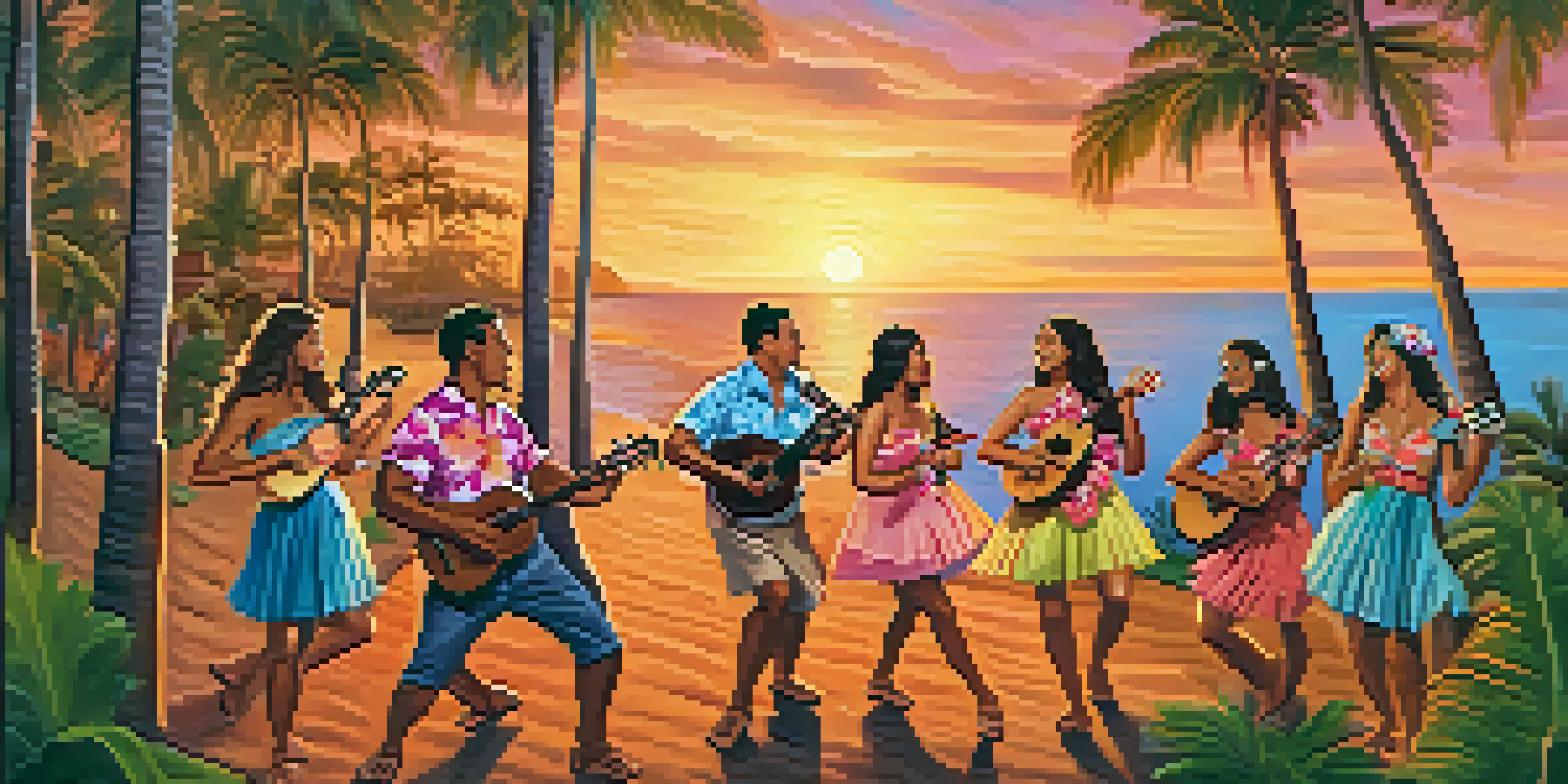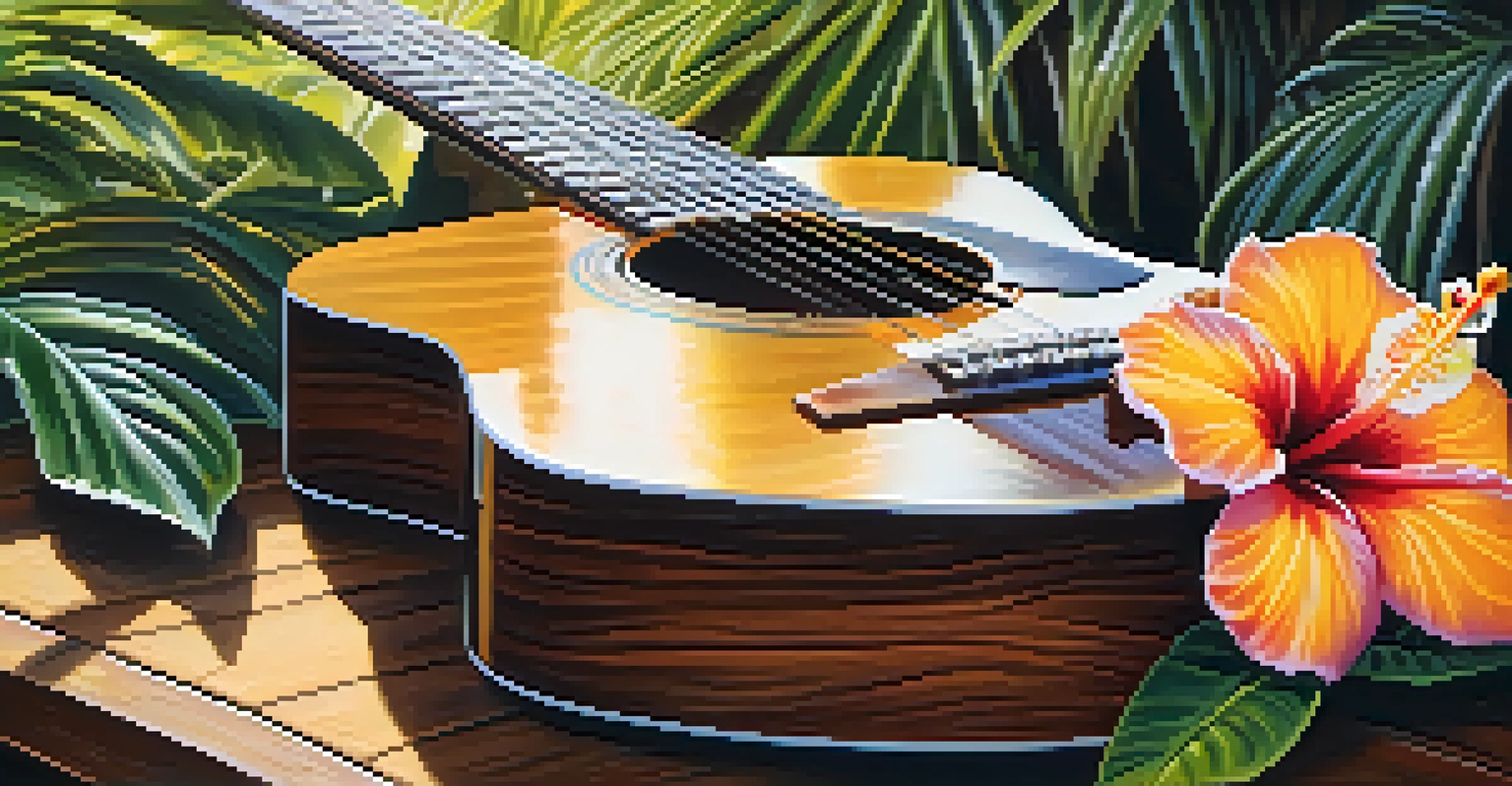Comprehending Hawaiian Music: Instruments and Traditional Songs

The Essence of Hawaiian Music: A Cultural Journey
Hawaiian music is not just a collection of melodies; it's a reflection of the islands' rich history and culture. This art form combines the influences of native Hawaiian chants, Western harmonies, and the rhythms brought by various immigrant groups. As you listen, you'll find stories of nature, love, and ancestry woven into the fabric of the songs.
Hawaiian music is the language of the heart, a way for us to express our love for the islands and our connection to one another.
Traditionally, music played a crucial role in Hawaiian life, from celebrations to storytelling. The use of instruments and vocal styles has evolved while remaining rooted in the past, allowing each generation to share their experiences. This connection to heritage makes Hawaiian music a living testament to the islands' spirit.
Whether you're sitting around a campfire or attending a luau, the sounds of Hawaiian music create a sense of community and belonging. It invites you to participate, sing along, and experience the warmth of island life, making it a cherished part of Hawaiian traditions.
Key Instruments in Hawaiian Music: A Closer Look
At the heart of Hawaiian music lies a few key instruments that bring its unique sound to life. The ukulele, with its cheerful tone and portable design, is perhaps the most iconic. Often seen in both traditional and contemporary settings, it evokes a sense of joy and togetherness, instantly transporting you to the islands.

Another essential instrument is the slack-key guitar, or 'ki hoalu,' which showcases a fingerstyle technique that creates soothing melodies. This style reflects the island's laid-back vibe, making it perfect for relaxing evenings. The use of alternate tunings gives each piece a distinctive sound that speaks to the listener's heart.
Hawaiian Music Reflects Cultural Heritage
Hawaiian music intertwines native chants, Western harmonies, and immigrant rhythms, embodying the islands' rich history and cultural narratives.
Last but not least, the pahu drum plays a vital role in traditional Hawaiian music, especially during hula performances. Made from a hollowed-out tree trunk and covered with sharkskin, it produces deep, resonant tones that drive the rhythm of the dance. The synergy between these instruments creates a rich tapestry of sound that embodies the Hawaiian spirit.
Traditional Hawaiian Songs: Stories Through Music
Traditional Hawaiian songs often tell stories of the land, sea, and people. These songs, or 'mele,' are steeped in history and serve as a way to preserve cultural narratives. For instance, 'Aloha ʻOe,' written by Queen Liliʻuokalani, captures the bittersweet feeling of parting while celebrating love for the islands.
Music is the heartbeat of Hawaiian culture, a lifeline that connects us to our ancestors and the land.
Many mele are also linked to specific locations, honoring the natural beauty and spiritual significance of the islands. Songs like 'Kauai' and 'Maui's Hula' pay tribute to the unique landscapes and rich biodiversity of Hawaii. By singing these songs, performers keep the island's stories alive for future generations.
Additionally, traditional songs often accompany hula, a dance that conveys the meaning of the lyrics through movement. This powerful combination of music and dance brings the stories to life, allowing listeners to feel the emotions and connections embedded in the songs. It’s a beautiful reminder of how art can bridge the gap between generations.
The Role of Hula in Hawaiian Music and Culture
Hula is an integral part of Hawaiian culture, intertwining dance and music in a way that tells a story. Originating from ancient times, it served both as a form of entertainment and a means of preserving history. Each movement in hula is choreographed to reflect the lyrics of the accompanying song, creating a visual narrative that enhances the experience.
The two main styles of hula, 'hula kahiko' (ancient hula) and 'hula ʻauana' (modern hula), showcase the evolution of this art form. Hula kahiko often uses traditional instruments like the ipu (gourd drum) and chants, while hula ʻauana incorporates contemporary influences and instruments such as the ukulele and guitar. This blend highlights the adaptability of Hawaiian culture.
Instruments Shape Hawaiian Sound
Key instruments like the ukulele and slack-key guitar create a unique and soothing sound that enhances the experience of Hawaiian music.
Participating in hula, whether as a dancer or an audience member, fosters a sense of community and connection. It invites everyone to join in the celebration of Hawaiian culture and music, making it a cherished activity during gatherings and festivals. Through hula, the spirit of aloha is shared and embraced, uniting people from all walks of life.
Modern Influences in Hawaiian Music: A Fusion of Styles
While rooted in tradition, Hawaiian music has also embraced modern influences that reflect the changing cultural landscape. Artists today blend elements of reggae, pop, and rock with traditional Hawaiian sounds, creating a fusion that resonates with a wider audience. This evolution showcases the versatility and relevance of Hawaiian music in contemporary society.
For example, musicians like Jack Johnson and Israel Kamakawiwoʻole have gained international acclaim, bringing Hawaiian music to global stages. Their unique styles incorporate storytelling and heartfelt lyrics, making their songs relatable to listeners everywhere. This cross-cultural exchange enriches the Hawaiian music scene while preserving its essence.
The rise of social media and digital platforms has also played a significant role in promoting Hawaiian music. Artists can share their work with a broader audience, allowing fans to discover and appreciate the beauty of Hawaiian melodies. This accessibility not only supports local musicians but also fosters a sense of pride in Hawaiian culture.
The Significance of Aloha and Its Connection to Music
The concept of 'aloha' goes beyond a simple greeting; it's a way of life that embodies love, compassion, and respect. In Hawaiian music, the spirit of aloha is woven into the lyrics and melodies, creating a deep emotional connection between the performers and their audience. This connection is what makes Hawaiian music so special and enduring.
When musicians sing about love, nature, or community, they invite listeners to embrace the principles of aloha in their own lives. Songs that celebrate the beauty of the islands, like 'Pearly Shells,' evoke feelings of gratitude and appreciation for the natural world. This sense of reverence is a cornerstone of Hawaiian culture.
Aloha Spirit Connects Through Music
The essence of 'aloha' permeates Hawaiian music, fostering emotional connections and promoting community among performers and audiences alike.
Furthermore, the spirit of aloha encourages collaboration and support among artists, fostering a close-knit community. This shared sense of purpose helps keep the traditions alive while inspiring new generations to explore and express their creativity. Ultimately, the music serves as a reminder of the values that unite us all.
Preserving Hawaiian Music: Challenges and Initiatives
Despite the rich heritage of Hawaiian music, it faces challenges in preservation and promotion. Globalization and the influence of mainstream music can overshadow traditional sounds, risking the loss of cultural identity. However, many dedicated individuals and organizations work tirelessly to ensure that Hawaiian music remains vibrant and accessible.
Initiatives like music festivals, educational programs, and community workshops play a crucial role in this effort. They provide opportunities for both locals and visitors to engage with Hawaiian music, learn about its history, and appreciate its significance. These events foster a sense of pride and connection to the islands, encouraging participants to carry on the traditions.

Moreover, the rise of digital platforms allows for the preservation and sharing of traditional Hawaiian music in innovative ways. Artists and educators can use technology to reach broader audiences, ensuring that the stories and sounds of Hawaii continue to resonate. Through these collective efforts, the future of Hawaiian music remains bright, celebrating its past while embracing the present.